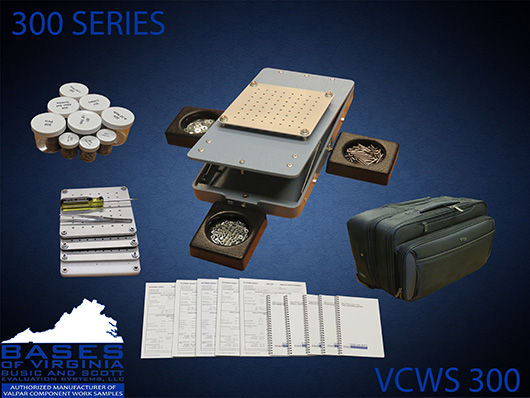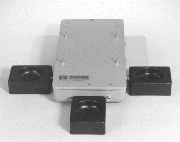
Click here to shop for VCWS 300 Series – Series Dexterity Modules parts and supplies
The 300 Series Dexterity Modules include five six-inch square plates (numbered 301-305) that fasten, one at a time, onto a lightweight plastic box (the Base Unit). Each plate has several unique exercises of short duration which assess various aspects of hand function and upper extremity range of motion. The exercises may be administered to the client either horizontally or at a 45 degree angle of presentation. The exercises focus primarily upon tasks which require fine finger and manual dexterity, and eye-hand coordination. The exercises assess upper body range of motion, strength, flexibility, ability to follow instructions, memory and many secondary work-related characteristics. All of the exercises have Method-Time-Measurement (MTM) industrial work rate standards to aid in the interpretation of scores and, as such, provide a ready means of comparing client performance to industrial work rate standards. They are also referenced to the work-related factor domain of the U.S. Department of Labor in its Dictionary of Occupational Titles.
 |
300. BASE UNIT – The Base Unit is a plastic box, 7 1/8″ x 14 1/8″ x 2 1/4″, weighing approximately three pounds. It has a hinged lid with supports that hold it at a 45 degree angle. The lid has four metal prongs used to attach the various plates. Three small parts bins affix to the box in metal jacks located at various positions on the front, sides, and back. A non-skid mat on the bottom of the Base Unit helps ensure stability. The Base Unit comes in a lightweight carrying case that will accommodate all of the modules. |
![[301. Small Parts Assembly]](https://www.basesofva.com/images/301.gif) |
301. SMALL PARTS ASSEMBLY – Number 301 has 64 holes in an 8 x 8 grid. There are several standard exercises – Placement, Assembly, and Disassembly – each divided into sections for dominant and non-dominant hands. Clients must place pins, washers, and collars into the 64 holes of the plate and then remove and replace the components into the correct bins. The exercises require fine finger dexterity, eye-hand coordination, bi-manual coordination, short term memory, ability to follow instructions, concentration skill, visual acuity and accommodation, and other secondary characteristics. |
![[302. Asymmetric Pin Placement]](https://www.basesofva.com/images/302.gif) |
302. ASYMMETRIC PIN PLACEMENT – Number 302 has 64 “D” shaped holes that are arranged in an 8 x 8 grid. The holes are situated in the plate with their flat sides at random angles within each row. Two standard exercises are administered to both the dominant and non-dominant hands separately. The exercises require fine finger dexterity, manual dexterity, motor coordination, eye-hand coordination, spatial aptitude, form perception, and various secondary characteristics such as ability to follow instructions and concentration skill, and so forth. The exercises make a variety of physical demands, such as visual acuity and accommodation. |
![[303. Tool Manipulation]](https://www.basesofva.com/images/303.gif) |
303. TOOL MANIPULATION – Number 303 has 48 threaded holes of two sizes: #6 and #8. In the standard administration of the assembly exercises, the client places machine screws into the proper holes by hand and uses a screwdriver to turn the screws down. The screws are then removed and placed back into the parts bin. The exercises of 303 require finger and manual dexterity, eye-hand coordination, bi-manual coordination, and size discrimination ability. They make a number of other physical demands, and elicit information on various secondary characteristics, such as frustration tolerance, ability to follow instructions, concentration skill, and so forth. |
![[304. Bi-Manual Coordination]](https://www.basesofva.com/images/304.gif) |
304. BI-MANUAL COORDINATION – Number 304 has 100 holes in 10 rows. The client picks up a size 8 headless machine screw in one hand while picking up a nut in the other. As quickly as possible, the client starts the nut onto the screw with one turn and then places the assembly into a hole on the plate. The process is reversed in the Disassembly exercises. The exercises require bi-manual coordination, finger and manual dexterity, eye-hand coordination, various physical demands involving eyes and upper extremities, and other secondary characteristics, such as ability to follow instructions, concentration skill, and so forth. |
![[305. Angled Pin Placement]](https://www.basesofva.com/images/305.gif) |
305. ANGLED PIN PLACEMENT – Number 305 has 100 small holes arranged in a 10 x 10 grid. The holes enter the plate at five different angles, one angle per row; and each is presented once in the top five rows and is repeated in the last five rows. Clients must use tweezers to pick up and place pins into the holes. The exercises require reasoning ability, manual dexterity, finger dexterity, motor coordination, eye-hand coordination, spatial aptitude, and various other skills and secondary characteristics, such as frustration tolerance, ability to follow instructions, concentration skill and so forth. |
Shipping Size and Weight: 24″ x 20″ x 18″ – 23 lbs.
